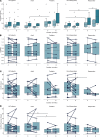A phase Ib/IIa clinical trial of dantrolene sodium in patients with Wolfram syndrome
- PMID: 34185708
- PMCID: PMC8410026
- DOI: 10.1172/jci.insight.145188
A phase Ib/IIa clinical trial of dantrolene sodium in patients with Wolfram syndrome
Abstract
BACKGROUNDWolfram syndrome is a rare ER disorder characterized by insulin-dependent diabetes mellitus, optic nerve atrophy, and progressive neurodegeneration. Although there is no treatment for Wolfram syndrome, preclinical studies in cell and rodent models suggest that therapeutic strategies targeting ER calcium homeostasis, including dantrolene sodium, may be beneficial.METHODSBased on results from preclinical studies on dantrolene sodium and ongoing longitudinal studies, we assembled what we believe is the first-ever clinical trial in pediatric and adult Wolfram syndrome patients with an open-label phase Ib/IIa trial design. The primary objective was to assess the safety and tolerability of dantrolene sodium in adult and pediatric Wolfram syndrome patients. Secondary objectives were to evaluate the efficacy of dantrolene sodium on residual pancreatic β cell functions, visual acuity, quality-of-life measures related to vision, and neurological functions.RESULTSDantrolene sodium was well tolerated by Wolfram syndrome patients. Overall, β cell functions were not significantly improved, but there was a significant correlation between baseline β cell functions and change in β cell responsiveness (R2, P = 0.004) after 6-month dantrolene therapy. Visual acuity and neurological functions were not improved by 6-month dantrolene sodium. Markers of inflammatory cytokines and oxidative stress, such as IFN-γ, IL-1β, TNF-α, and isoprostane, were elevated in subjects.CONCLUSIONThis study justifies further investigation into using dantrolene sodium and other small molecules targeting the ER for treatment of Wolfram syndrome.TRIAL REGISTRATIONClinicalTrials.gov identifier NCT02829268FUNDINGNIH/National Institute of Diabetes and Digestive and Kidney Diseases (NIDDK) (DK112921, DK113487, DK020579), NIH/National Center for Advancing Translational Sciences (NCATS) (TR002065, TR000448), NIH training grant (F30DK111070), Silberman Fund, Ellie White Foundation, Snow Foundation, Unravel Wolfram Syndrome Fund, Stowe Fund, Eye Hope Foundation, Feiock Fund, Washington University Institute of Clinical and Translational Sciences grant UL1TR002345 from NIH/NCATS, Bursky Center for Human Immunology & Immunotherapy Programs.
Keywords: Cell stress; Diabetes; Endocrinology; Genetic diseases; Genetics.
Conflict of interest statement
Figures



References
Publication types
MeSH terms
Substances
Associated data
Grants and funding
LinkOut - more resources
Full Text Sources
Medical

